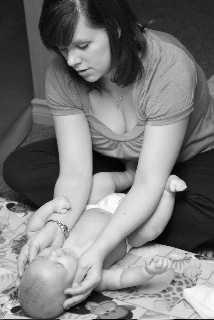A while back, the Regina Qu’Appelle Health District invited Dianne Younker, Adminstrator of Women’s and Infants’ programs at Toronto’s Mount Sinai Hospital, to come to Regina and speak about Family Centred Care. Part of Dianne’s stay in Regina included a public forum on maternity services with our health district.
I attended this forum and invited my past clients to attend at well. Many responded that they were interested but were unable to attend and asked that I share what was discussed at the meeting. So I decided that this would be a good place to report on the details for the forum.
The majority of the evening focused on what is Family Centred Care and what does it look like and feel like for patients and their family. The basic premise of family centred care is that when a patient is supported by their family while receiving treatment, then the patient’s emotional and mental health is much better. This makes a lot of sense. When you take care of the emotional health of a patient, their physical health will improve. It goes hand in hand.
So as our hospital moves in this direction, some changes are being made in regards to moms and babies. For one, dads can now stay at the hospital with mom for the duration of her stay. If mom is having a c-section, then usually during the procedure she will allow to have her partner plus a second support person can stay with her the whole time. Babies can stay with mom in the event of the C-section. The medical staff comes to the baby rather than taking the baby away. This one the hospital is still working on. Currently the babies are taking away for the postnatal checks, but hopefully by early 2010 the babies will be staying the room with mom. And another change is that they are more strongly encouraging babies to stay with mom at all times while mom is in the mother baby unit. With the new renovations that are being done, there will be more rooms for moms to stay at the hospital if their baby is in the NICU, and they themselves have been discharged. There will be recliners beside the incubators so that moms and dads can comfortably stay close to their baby. It’s also a change in the way that the nursing staff approach their patients. Rather than coming into the room of a new mom and her baby and stating that now they are going to do this and that. They can come in and say, “Listen we have some time today to focus on what you need help with. There are also some things that I need to do with baby but I want to hear from you as well about what you would like help with.” Even just reading that statement, doesn’t that feel good? It’s a much more collaborative approach.
Another part of this philosophy that I really love, is the idea that neither the doctor (nurse) or the patient has all the answers and that the best care arises from a clear communication between all the participants – doctor or nurse and patient. It comes from the belief that just because two people have the same illness, doesn’t necessary mean that they need exactly the same care. Birth isn’t an illness, but this philosophy is so appropriate in the area of birth. Just because two women are giving birth doesn’t mean that they need the same care. In fact quite likely they will have different ideas about what is a good birth experience and what kind of care and support they need. And I’m so glad that this is being acknowledged.
Congrats to the Regina Qu’appelle Health Region for moving towards this type of care for families! We’ll all benefit. 🙂
Marie
Below is some additional information from the Institute for Family Centered Health Care.
http://www.familycenteredcare.org/index.html
What is patient- and family-centered health care?
Patient- and family-centered care is an innovative approach to the planning, delivery, and evaluation of health care that is grounded in mutually beneficial partnerships among health care patients, families, and providers. Patient- and family-centered care applies to patients of all ages, and it may be practiced in any health care setting.
What are the core concepts of patient- and family-centered care?
- Dignity and Respect. Health care practitioners listen to and honor patient and family perspectives and choices. Patient and family knowledge, values, beliefs and cultural backgrounds are incorporated into the planning and delivery of care.
- Information Sharing. Health care practitioners communicate and share complete and unbiased information with patients and families in ways that are affirming and useful. Patients and families receive timely, complete, and accurate information in order to effectively participate in care and decision-making.
- Participation. Patients and families are encouraged and supported in participating in care and decision-making at the level they choose.
- Collaboration. Patients and families are also included on an institution-wide basis. Health care leaders collaborate with patients and families in policy and program development, implementation, and evaluation; in health care facility design; and in professional education, as well as in the delivery of care.
Patient- and Family-Centered Care Core Concepts
What is meant by the word “family”?
The word “family” refers to two or more persons who are related in any way—biologically, legally, or emotionally. Patients and families define their families.
In the patient- and family-centered approach, the definition of family, as well as the degree of the family’s involvement in health care, is determined by the patient, provided that he or she is developmentally mature and competent to do so. The term “family-centered” is in no way intended to remove control from patients who are competent to make decisions concerning their own health care. In pediatrics, particularly with infants and young children, family members are defined by the patient’s parents or guardians.
Is the term family-centered, patient-centered, or patient- and family-centered care?
In the early 1990s, the Institute’s work focused primarily on family-centered approaches to pediatric care. Within this framework, it was always recommended however, that as patients matured, they should be encouraged to become more involved as decision-makers in their health care. As the Institute has become more involved in adult and geriatric care in the last 8-10 years, we have felt that it was important to make the acknowledgement of the patient’s role more explicit. Thus we now more commonly use the term patient- and family-centered care.
We believe that the term, “patient-centered care,” is not sufficient to adequately describe this approach to care for several reasons. The original definition of patient-centered care as discussed in the literature in the late 1980s and early 1990s did not include the concept of patients and families as advisors and essential partners in improving care practices and systems of care.
A second reason is that the majority of patients have some connection to family or support networks and it is important for the health system to encourage the continuing link to these natural supports. Due to the profound influence of families on patients’ health and well-being, families and other supportive persons should be viewed as allies in efforts to enhance safety and quality in health care.
A third reason to be explicit in the use of the term, “patient- and family-centered care,” is that social isolation is a risk factor in today’s society. Individuals, who are most dependent on hospital care and the broader health care system, are also often most dependent on families and other support networks:
- The very young;
- The very old; and
- Those with chronic conditions.
Hospitals, clinics and other health care agencies that make an explicit commitment to patient- and family-centered care develop policies, programs, and practices collaboratively with patients and families that support and encourage family presence and participation.
Is there a difference between family-centered care and family-focused care?
While both approaches acknowledge involvement with the family as a fundamental element of care, there are key differences. In family-focused care, professionals often provide care from the position of an “expert -” assessing the patient and family, recommending a treatment or intervention and creating a plan for the family to follow. They do things to and for the patient and family, regarding the family as the “unit of intervention.” Family-centered care, by contrast, is characterized by a collaborative approach to caregiving and decision-making. Each party respects the knowledge, skills, and experience that the other brings to health care encounters. The family and health care team collaboratively assess the needs and development of the treatment plan.
Does patient- and family-centered care take more time?
Implementing a patient- and family-centered approach does require an up-front investment in relationship building. Staff must have opportunities to explore how they currently interact with patients and families, to discuss and reflect on the value of collaborative approaches, and to build new knowledge and skills. For family-centered care to be effectively implemented in any healthcare setting, the staff must honestly assess how they are currently treating their patients and how this can change. Just undertaking this honest assessment is very valuable for the institution.
Patients and families, who are more accustomed to being passive recipients of care, will require time and training to learn new skills and strategies to become active participants in care and decision-making. Patients and family members who will play key roles on hospital committees or task forces will need training and mentoring .
The time it takes to build these partnerships and acquire appropriate knowledge and skills will eventually be repaid several fold. When administrators, clinicians, patients and families have a shared understanding of, and respect for, what each brings to the health care experience, the stage is set for mutually beneficial relationships. With shared priorities and goals, time will most likely not be wasted on repetitive, ineffective, or counterproductive activities. The possibility of misunderstanding, dissatisfaction, and even medical error is greatly diminished.
Does patient- and family-centered care cost more?
Many aspects of patient- and family-centered care do not cost more money; they simply require a change in attitude and approach. Patient- and family-centered care improves the quality and effectiveness of communication. It is proactive, rather than reactive. As a result, many problems are prevented, and others are handled before they grow out of control.
Introducing patient- and family-centered care does entail some initial and ongoing education costs. But the costs of failed communication and trust—often quantified in terms of poor patient outcomes, wasted resources, and malpractice litigation—are much higher.
Environments that support the presence and participation of families and ensure a healing environment with privacy for patients and families may be more expensive to build. These initial design costs are quickly recouped, often in quantifiable terms, as demonstrated by lower infection rates, higher patient and staff satisfaction ratings, and improved market share. A healing environment that offers appropriate space for families is more supportive of staff and thus enhances staff satisfaction and retention.
What are strategies to overcome staff resistance?
Administrative and clinical leaders should begin by setting a positive example, modeling collaboration with patients and families. Other steps include ensuring that staff have the appropriate resources to practice patient- and family-centered care and rewarding exemplary practice.
For example, it is helpful to create forums at which staff can voice their concerns and then provide educational programs to address these concerns. Providing staff with the resources and support they need to effectively partner with patients and families usually leads to change in practice and attitudes. Programs that feature patients and families as faculty—where they recount their own experiences within the health care system—helps broaden staff perspectives and understanding. As part of these efforts, inviting staff to think about their own health care experiences and how these experiences influence their own practice assists staff in learning about patient- and family-centered care on both intellectual and emotional levels.
Another effective technique is to develop patient- and family-centered champions across the hospital or agency. This can be done by asking managers, clinicians, and support staff who are already interested in or knowledgeable about patient- and family-centered care to serve on committees and task forces with patients and families. When possible, choose staff who are already viewed as opinion leaders by their peers for these roles.
Involving staff in the process of measuring changes and improvements as well as structuring plans for dissemination and the spread of innovation, helps overcome resistance. Providing staff opportunities to share their positive experiences and engage in problem-solving discussions in areas of concern are also helpful strategies.
How do we identify patients and families to serve in advisory roles?
Ask staff and physicians to recommend patients and families whom they believe may be effective advisors. Contact peer support groups in the community or groups that are affiliated with the clinical programs at the hospital or agency. Review satisfaction surveys for individuals who have constructive ideas to share for improving care experiences.
Once a pool of potential candidates has been identified, some organizations invite patients and families to come to an exploratory meeting about serving as advisors. Others convene an informal workgroup of patients and families as a way of building mutual understanding and trust for this collaborative process.
What qualities should we look for in selecting patients and family members as committee members and advisors?
Individuals serving as patient or family advisors should reflect a range of experiences within the unit, hospital, or agency and should be representative of the community served.
In reviewing possible candidates for advisory positions, look for individuals who:
- Share insights and information about their experiences in ways that others can learn from them.
- Show concern for more than one issue or agenda.
- Listen well.
- Respect the perspectives of others.
- Speak comfortably and candidly in a group.
- Interact well with many different kinds of people.
- Work in partnerships with others.
- See beyond their own personal experience.





One thought on “Family Centred Care at the Hospital – What does it mean for you?”